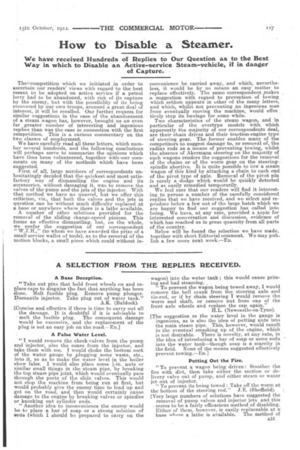How to Disable a Steamer.
Page 17

If you've noticed an error in this article please click here to report it so we can fix it.
We have received Hundreds of Replies to Our Question as to the Best Way in which to Disable an Active-service Steam-vehicle, if in danger of Capture.
Th6:-competition which we initiated in order to ascertain our readers' views with regard to :the best means to be adopted on active service if a petrol lorry had to be abandoned, with risk of its capture by the enemy, but with the possibility of its being recovered by our own troops, aroused a great deal of interest, it will be recalled. Our further request for similar suggestions in the cave of the abandonment of a steam wagon has, however, brought us an even far greater number of interesting and ingenious replies than was the case in connection with the first competition. This is a. curious commentary on the two classes of employment. We have carefully read all these letters, which number several hundreds, and the following conclusions will perhaps serve to summarize the °Pinions which have thus be-en volunteered., together with our comments on raaay of, the methods which have been. suggested. First of all, large numbers of correspondents unhesitatingly decided that the quickest and most satisfactory way of dismantling the engine and • its accessories, without damaging it. was to remove the valves of the pump and the jets of the injector. With that method we have no quarrel, but we offer this criticism, viz., that both the valves and the jets in question can be without much difficulty replaced at a base or anywhere where there is a lathe available.
A number of Other solutions provided for the removal of the sliding change-speed pinions. This forms an effective dismantling, but, on the whole, We prefer the suggestion of our correspondent "_VT.J.E.," (to whom we have awarded the prize of a small service wallet of tools), as to the removal of the motion blocks, a small piece which could.without in convenience be carried away, and which, nevertheleas, it would be by no means an easy matter to replace effectively. The same correspondent Flakes , a suggestion with regard: to prevention, of towing which seldom appears in other of the many letters, and which, whilst not preventing an ingenious man from eventually moving the machine, would effee tively stop its haulage tor some while. Two characteristics of the steam wagon, and in particular of the overtype models with which apparently the majority of our correspondents deal, are their chain drives and their traction-engine type of steering gear. T.he former enables many of the competitors to suggest damage to, or removal of, the radius rods as a means of preventing towing, whilst the absence of Akermann steering on the majority of such wagons renders the suggestions for the removal. of the chains or of the worm gear on the steeringspindle abortive. It is quite possible to tow a steamn wagon of this kind by attaching a chain to each end of the pivot type of axle. Removal of the pivot pin is surely a dodge which Would be quickly detected and as easily remedied temporarily. We feel sure that our readers will find it interesting to peruse a number of the carefully •considered replies that we have received, and we select and reproduce below a few out of the large batch which we are happy to find our suggestion has called into being. We. have, at any rate, provided a topic for interested conversation and discussion, evidence of which has reached us in grew: quantity from all parts of the country.
Below will be found the selectionwe have made, together with short Editorial comment. We may .publish a few more next week..—En.






















